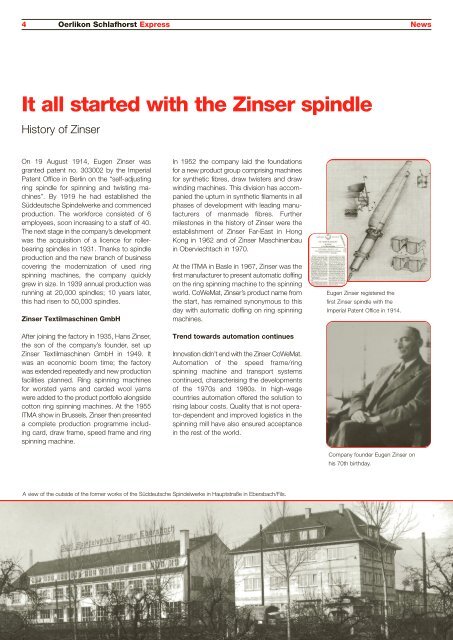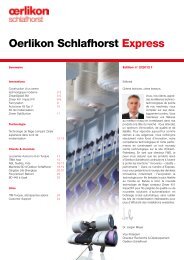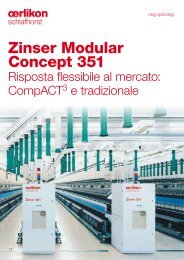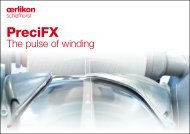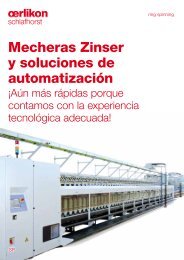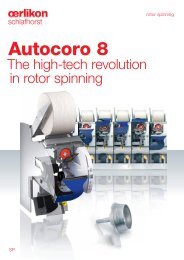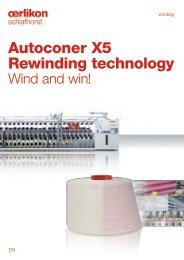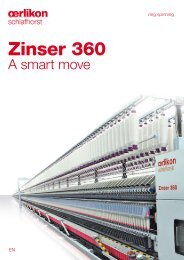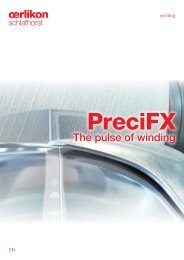Oerlikon Schlafhorst Express - Oerlikon Schlafhorst - Oerlikon Textile
Oerlikon Schlafhorst Express - Oerlikon Schlafhorst - Oerlikon Textile
Oerlikon Schlafhorst Express - Oerlikon Schlafhorst - Oerlikon Textile
Create successful ePaper yourself
Turn your PDF publications into a flip-book with our unique Google optimized e-Paper software.
4 <strong>Oerlikon</strong> <strong>Schlafhorst</strong> <strong>Express</strong><br />
News<br />
It all started with the Zinser spindle<br />
History of Zinser<br />
On 19 August 1914, Eugen Zinser was<br />
granted patent no. 303002 by the Imperial<br />
Patent Office in Berlin on the “self-adjusting<br />
ring spindle for spinning and twisting machines”.<br />
By 1919 he had established the<br />
Süddeutsche Spindelwerke and commenced<br />
production. The workforce consisted of 6<br />
employees, soon increasing to a staff of 40.<br />
The next stage in the company’s development<br />
was the acquisition of a licence for rollerbearing<br />
spindles in 1931. Thanks to spindle<br />
production and the new branch of business<br />
covering the modernization of used ring<br />
spinning machines, the company quickly<br />
grew in size. In 1939 annual production was<br />
running at 20,000 spindles; 10 years later,<br />
this had risen to 50,000 spindles.<br />
Zinser Textilmaschinen GmbH<br />
After joining the factory in 1935, Hans Zinser,<br />
the son of the company’s founder, set up<br />
Zinser Textilmaschinen GmbH in 1949. It<br />
was an economic boom time; the factory<br />
was extended repeatedly and new production<br />
facilities planned. Ring spinning machines<br />
for worsted yarns and carded wool yarns<br />
were added to the product portfolio alongside<br />
cotton ring spinning machines. At the 1955<br />
ITMA show in Brussels, Zinser then presented<br />
a complete production programme including<br />
card, draw frame, speed frame and ring<br />
spinning machine.<br />
In 1952 the company laid the foundations<br />
for a new product group comprising machines<br />
for synthetic fibres, draw twisters and draw<br />
winding machines. This division has accompanied<br />
the upturn in synthetic filaments in all<br />
phases of development with leading manufacturers<br />
of manmade fibres. Further<br />
milestones in the history of Zinser were the<br />
establishment of Zinser Far-East in Hong<br />
Kong in 1962 and of Zinser Maschinenbau<br />
in Oberviechtach in 1970.<br />
At the ITMA in Basle in 1967, Zinser was the<br />
first manufacturer to present automatic doffing<br />
on the ring spinning machine to the spinning<br />
world. CoWeMat, Zinser’s product name from<br />
the start, has remained synonymous to this<br />
day with automatic doffing on ring spinning<br />
machines.<br />
Trend towards automation continues<br />
Innovation didn’t end with the Zinser CoWeMat.<br />
Automation of the speed frame/ring<br />
spinning machine and transport systems<br />
continued, characterising the developments<br />
of the 1970s and 1980s. In high-wage<br />
countries automation offered the solution to<br />
rising labour costs. Quality that is not operator-dependent<br />
and improved logistics in the<br />
spinning mill have also ensured acceptance<br />
in the rest of the world.<br />
A view of the outside of the former works of the Süddeutsche Spindelwerke in Hauptstraße in Ebersbach/Fils.<br />
Eugen Zinser registered the<br />
first Zinser spindle with the<br />
Imperial Patent Office in 1914.<br />
Company founder Eugen Zinser on<br />
his 70th birthday.


